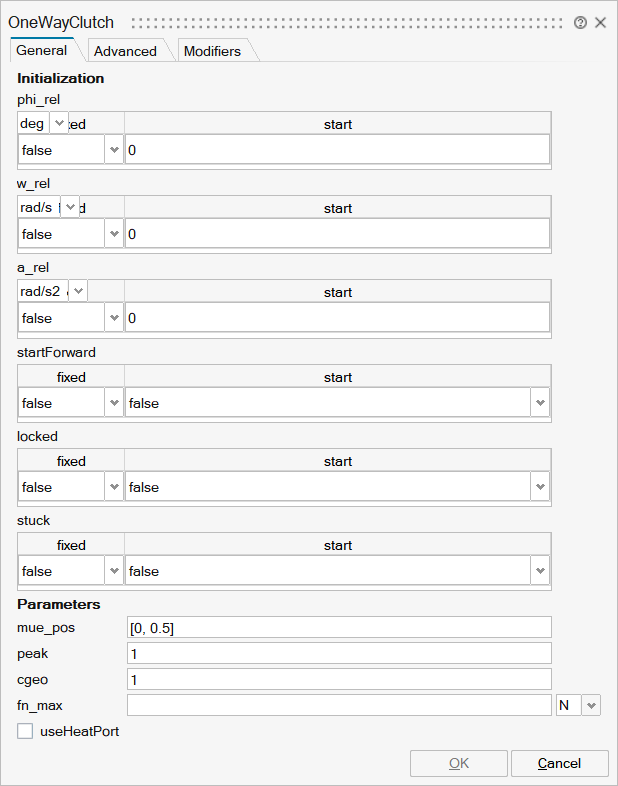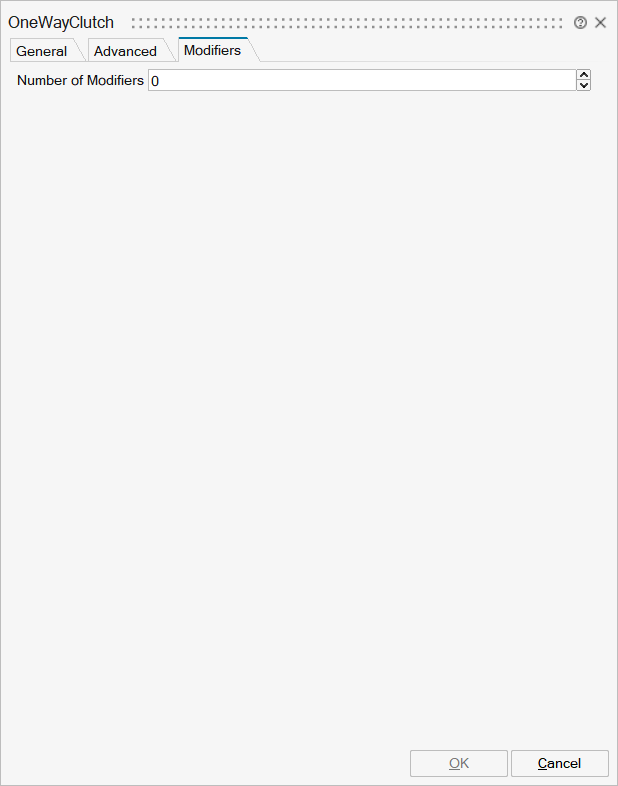OneWayClutch
Parallel connection of freewheel and clutch
![]()
Library
Modelica/Mechanics/Rotational/Components
Description
This component models a one-way clutch, i.e., a component withtwo flanges where friction is present between the two flangesand these flanges are pressed together via a normal force. Theseflanges may be sliding with respect to each other.
A one-way-clutch is an element where a clutch is connected in parallelto a free wheel. This special element is provided, because sucha parallel connection introduces an ambiguity into the model(the constraint torques are not uniquely defined when bothelements are stuck) and this element resolves it by introducingone constraint torque only instead of two constraints.
Note, initial values have to be chosen for the model such that therelative speed of the one-way-clutch ≥ 0. Otherwise, the configurationis physically not possible and an error occurs.
The normal force fn has to be provided as input signal f_normalized in a normalized form(0 ≤ f_normalized ≤ 1),fn = fn_max * f_normalized, where fn_max has to be provided as parameter.
The friction in the clutch is modeled in the following way.When the relative angular velocity is positive, the friction torque is afunction of the velocity dependent friction coefficient mu(w_rel), ofthe normal force fn, and of a geometry constant cgeo which takes intoaccount the geometry of the device and the assumptions on the frictiondistributions:
frictional_torque = cgeo * mu(w_rel) * fn
Typical values of coefficients of friction mu:
- 0.2 … 0.4 for dry operation,
- 0.05 … 0.1 when operating in oil.
The geometry constant is calculated - under theassumption of a uniform rate of wear at the friction surfaces - in the following way:
cgeo = N*(r0 + ri)/2
where ri is the inner radius,ro is the outer radius and N is the number of friction interfaces,
The positive part of the friction characteristic mu(w_rel),w_rel >= 0, is defined via table mu_pos (first column = w_rel,second column = mu). Currently, only linear interpolation inthe table is supported.
When the relative angular velocity w_rel becomes zero, the elementsconnected by the friction element become stuck, i.e., the relativeangle remains constant. In this phase the friction torque iscalculated from a torque balance due to the requirement thatthe relative acceleration shall be zero. The elements beginto slide when the friction torque exceeds a threshold value,called the maximum static friction torque, computed via:
frictional_torque = peak * cgeo * mu(w_rel=0) * fn, (peak >= 1)
This procedure is implemented in a "clean" way by state events andleads to continuous/discrete systems of equations if friction elementsare dynamically coupled. The method is described in(see also a short sketch in UsersGuide.ModelingOfFriction):
- Otter M., Elmqvist H., and Mattsson S.E. (1999):
- Hybrid Modeling in Modelica based on the Synchronous Data Flow Principle. CACSD'99, Aug. 22.-26, Hawaii.
See also the discussionState Selectionin the User's Guide of the Rotational library.
Parameters

| Name | Label | Description | Data Type | Valid Values |
|---|---|---|---|---|
mo_phi_rel | phi_rel | phi_rel | Structure | |
mo_phi_rel/fixed | fixed | Cell of scalars | true | |
mo_phi_rel/start | start | Cell of scalars | ||
mo_w_rel | w_rel | w_rel | Structure | |
mo_w_rel/fixed | fixed | Cell of scalars | true | |
mo_w_rel/start | start | Cell of scalars | ||
mo_a_rel | a_rel | a_rel | Structure | |
mo_a_rel/fixed | fixed | Cell of scalars | true | |
mo_a_rel/start | start | Cell of scalars | ||
mo_startForward | startForward | startForward | Structure | |
mo_startForward/fixed | fixed | Cell of scalars | true | |
mo_startForward/start | start | Cell of scalars | true | |
mo_locked | locked | locked | Structure | |
mo_locked/fixed | fixed | Cell of scalars | true | |
mo_locked/start | start | Cell of scalars | true | |
mo_stuck | stuck | stuck | Structure | |
mo_stuck/fixed | fixed | Cell of scalars | true | |
mo_stuck/start | start | Cell of scalars | true | |
mo_mu_pos | mu_pos | Positive sliding friction coefficient [-] as function of w_rel [rad/s] (w_rel>=0) | Matrix of size Mx2 | |
mo_peak | peak | Peak for maximum value of mu at w==0 (mu0_max = peak*mu_pos[1,2]) | Scalar | |
mo_cgeo | cgeo | Geometry constant containing friction distribution assumption | Scalar | |
mo_fn_max | fn_max | Maximum normal force | Scalar | |
mo_useHeatPort | useHeatPort | = true, if heatPort is enabled | Number | 0 |
mo_peak2 | peak2 | Scalar |

| Name | Label | Description | Data Type | Valid Values |
|---|---|---|---|---|
mo_phi_nominal | phi_nominal | Nominal value of phi_rel (used for scaling) | Scalar | |
mo_stateSelect | stateSelect | Priority to use phi_rel and w_rel as states | Structure | |
mo_stateSelect/choice1 | StateSelect.never | Number | 0 | |
mo_stateSelect/choice2 | StateSelect.avoid | Number | 0 | |
mo_stateSelect/choice3 | StateSelect.default | Number | 0 | |
mo_stateSelect/choice4 | StateSelect.prefer | Number | 0 | |
mo_stateSelect/choice5 | StateSelect.always | Number | 0 | |
mo_w_small | w_small | Relative angular velocity near to zero if jumps due to a reinit(..) of the velocity can occur (set to low value only if such impulses can occur) | Scalar |

| Name | Label | Description | Data Type | Valid Values |
|---|---|---|---|---|
mo__nmodifiers | Number of Modifiers | Specifies the number of modifiers | Number | |
mo__modifiers | Modifiers | Add new modifier | Structure | |
mo__modifiers/varname | Variable name | Cell of strings | 'tau' | |
mo__modifiers/attribute | Attribute | Cell of strings | 'start' | |
mo__modifiers/value | Value |
Ports
| Name | Type | Description | IO Type | Number |
|---|---|---|---|---|
flange_a | implicit | Left flange of compliant 1-dim. rotational component | input | 1 |
flange_b | implicit | Right flange of compliant 1-dim. rotational component | output | 1 |
f_normalized | implicit | Normalized force signal 0..1 (normal force = fn_max*f_normalized; clutch is engaged if > 0) | input | 2 |
Port 4 | implicit | Optional port to which dissipated losses are transported in form of heat | input | mo_useHeatPort |